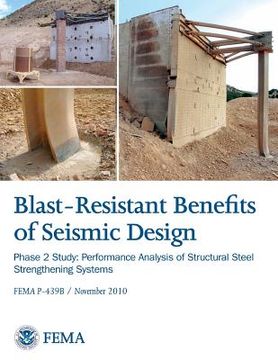Compartir
Blast-Resistance Benefits of Seismic Design - Phase 2 Study: Performance Analysis of Structural Steel Strengthening Systems (FEMA P-439B / November 20 (en Inglés)
Federal Emergency Management Agency
(Autor)
·
National Earthquake Hazards Red Program
(Autor)
·
U. S. Army Engineers
(Autor)
·
Createspace Independent Publishing Platform
· Tapa Blanda
Blast-Resistance Benefits of Seismic Design - Phase 2 Study: Performance Analysis of Structural Steel Strengthening Systems (FEMA P-439B / November 20 (en Inglés) - Agency, Federal Emergency Management ; Program, National Earthquake Hazards Red ; Engineers, U. S. Army
$ 31.300
$ 52.170
Ahorras: $ 20.870
Elige la lista en la que quieres agregar tu producto o crea una nueva lista
✓ Producto agregado correctamente a la lista de deseos.
Ir a Mis Listas
Origen: Estados Unidos
(Costos de importación incluídos en el precio)
Se enviará desde nuestra bodega entre el
Jueves 30 de Mayo y el
Martes 11 de Junio.
Lo recibirás en cualquier lugar de Chile entre 1 y 3 días hábiles luego del envío.
Reseña del libro "Blast-Resistance Benefits of Seismic Design - Phase 2 Study: Performance Analysis of Structural Steel Strengthening Systems (FEMA P-439B / November 20 (en Inglés)"
The Federal Emergency Management Agency (FEMA) and the National Earthquake Hazards Reduction Program (NEHRP) both have a similar goal, which is to encourage design and building practices that address the earthquake hazard and minimize the resulting risk of damage and injury. A related FEMA goal is to present guidance that addresses all hazards in a coordinated manner. This publication is the second and final in a series developed with this related goal in mind, and examines the relationship between seismic resistant design and blast resistant design and attempts to quantify the blast resistance benefit a building designed to withstand high seismic loads would inherently incorporate. This series of publications was developed in response to the September 11, 2001 terrorist attacks on the New York World Trade Center and the subsequent events that led to the formation of DHS and an increased emphasis on preparedness and mitigation of terrorism-related hazards. One issue that FEMA began shortly after that was to examine whether lessons learned in response to natural hazards could be effectively applied to protect building occupants from human threats. Important similarities between seismic and blast loadings (e.g., both can impose extreme horizontal forces on a structure within a small time frame) lend themselves to such examination. The first publication of this series is Blast Resistance Benefits of Seismic Design Phase 1 Study: Performance Analysis of Reinforced Concrete Strengthening Systems Applied to the Murrah Federal Building Design (FEMA 439A, December 2005). This publication was developed based on data from the bombing of the Alfred P. Murrah Federal Building in Oklahoma City in April 1995. That event was documented in The Oklahoma City Bombing: Improving Building Performance Through Multi-Hazard Mitigation (FEMA 277, August 1996). The Phase 1 FEMA 439A report demonstrated that, with such seismic design features in place, the structural system would have been better able to dissipate and manage the blast load effects, reducing or avoiding catastrophic chain-reaction impacts on portions of the building that were not destroyed as a direct result of the bomb blast. This publication, Blast Resistance Benefits of Seismic Design Phase 2 Study: Performance Analysis of Steel Frame Strengthening Systems (FEMA 439B, November 2010), supplements the first phase study by using the same study scenario, but with a steel frame building. A federally owned steel frame building located in a low seismic area was selected from the GSA inventory and a series of seismic strengthening designs were developed based on the original plans. Both of these studies were performed under an agreement with the U.S. Army Engineer Research and Development Center (ERDC), Construction Engineering Research Laboratory (CERL) to conduct advanced structural analyses on specific examples of different construction types in order to quantify the blast resistance benefits afforded by appropriately designed seismic resistance features. The purpose of these studies is not to develop or support a hypothesis that seismic design is equivalent to blast-resistant design. The findings of these studies strongly indicate that a building originally designed or later upgraded to address high seismicity will also provide a significant level of blast resistance. Although cost constraints can be daunting for building owners who need to achieve higher levels of protection than conventional construction methods provide, the findings of this study should encourage an owner to consider the potential cost benefits of addressing both types of structural safety hazard in a coordinated or holistic way. Considering the significant blast resistance benefits offered by seismic design, the building owner may find that achieving complete blast protection requires only an incremental cost increase over some types of seismic strengthening described in this report.

